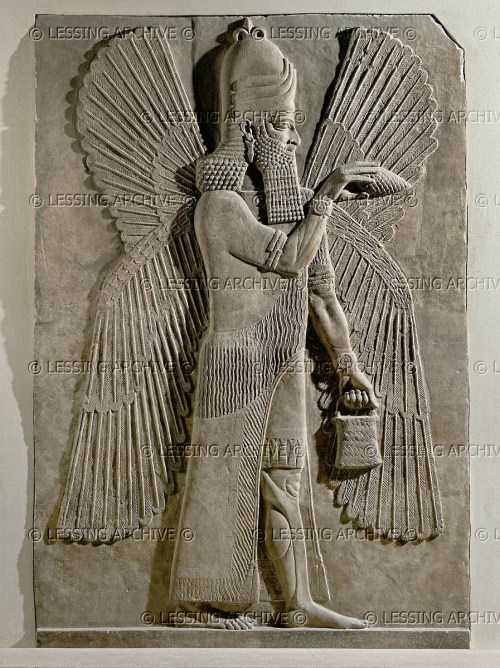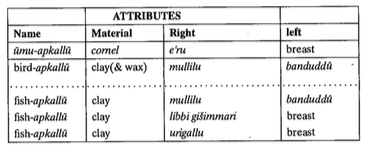On the Mullilu, the “cleaner,” the Purification Instrument of the Apkallu Exorcist
“–mullilu, “purification instrument” (literally: “cleaner”).
When it is agreed upon that a word denoting the cone, the most common object in the hands of the bird-apkallū and the fish-apkallū, must appear among the terms denoting objects held by the apkallū in ritual I/II, this word can only be mullilu.
The identification of mullilu as denoting the cone is based on the observation that the cone on reliefs, seals and in the Kleinplastik never occurs as the only object held by an apkallū; thus e’ru, libbi gišimmari, and urigallu, the other objects held by an apkallū, are excluded.
Klengel-Brandt (FuB 10 34, cf. Rittig Kleinplastik 215) thinks mullilu denotes “eine Art kurzen Wedel … der hauptsachlich zum besprengen mit Wasser benutzt worden ist“, and indentifies it with the cone. Correctly, but without justification, Parker (Essays Wilkinson 33) states that mullilu, “purifier”, “may be the cone-shaped object carried by the genii”.

Umu-Apkallū in the characteristic act of purification, sprinkling sacred water from the Banduddu bucket with the Mullilu cone.
From Nimrud, capital of king Ashurnarzipal.
AO 19845
Unclear is BBR 26 v 39ff. (restored from 28:9, quoted by CAD M/2 189a), where the king carries a mullilu in his right and in his left hand. Never, on seals, reliefs or as a statue, does a figure carry a cone in both his left and his right hand.
The identity of the cone is still being debated: male inflorescence of the date-palm, or cone of a coniferous tree (cf., with previous literature, Stearns AfOB 15 2443). In a recent study, the second option is hesitantly favoured (Bleibtreu, Flora 61f., 93f., 123f.).

A bird-apkallu with mullilu and banduddu.
Drawn by Faucher-Gudin from an Assyrian bas-relief from Khorsabad.
http://www.gutenberg.org/files/17323/17323-h/17323-h.htm#linkBimage-0011
The Akkadian term mullilu does not give a clue. From a philological point of view the fir-cone (terinnu) is preferable to the male inflorescence of the date-palm (rikbu, cf. Landsberger Date Palm 19): terinnu is attested as an instrument bringing about the release of sin (Maqlû I 24, cf. Landsberger Date Palm 14) and thus resembles the other objects carried by the apkallū. For rikbu no such use is known.
Regarding cone and bucket, we conclude with the following:
- The bucket is always carried in the left hand. The other hand may be empty, or may carry a variety of objects, such as the sprig (Kolbe Reliefprogramme Type VI), which occur also in the hands of figures not carrying buckets. The value of the bucket in the ritual cannot be dependent on the objects held in the other hand. The bucket, or rather its content, is effective simply by being present.
- One object, the cone, appears only when the figure in question carries a bucket in its left hand. The value of the cone must in some way be dependent on the value of the bucket.
- The texts indicate that the bucket contained holy water effectuating “release”. As was proposed before, the dependent cone “purifier”(mullilu) held in the right hand activated the holy water: it was a sprinkler (Klengel-Brandt, Rittig, CAD M/1l 189a).
- The figures carrying buckets (and cones) are engaged in a purification ritual. As will be seen below, this accords well with their function of apkallū.
- Figures carrying cones point their cone at the sacred tree, the king, or courtiers (Stearns AfOB 15 64f.). Figures standing in doorways and apparently pointing their cones at nothing, are perhaps best thought of as pointing their cones at passing visitors, just as the weapons and the gestures of greeting are directed at the visitors, and not at the building.
- The sacred tree benefits from the activities of the genii, the genii do not need the tree, cf. Stearns AfOB 15 70ff. It is not necessary to understand the meaning of the tree in order to understand the meaning of the figures with bucket and cone.
- For the tree we refer to Porada AASOR 24 108ff., Madhloon Sumer 26 137ff., Stearns AfOB 15 70ff. Genge AcOr 33 321ff., Hrouda BaM 3 41ff., Kolbe Reliefprogramme 83ff., Bleibtreu Flora 37ff., and passim, Parker Essays Wilkinson 38. For a doubtful connection with the texts, cf. van Dijk Syncretism 175 f., and Lugal 1 10 ff. (see below 000).”
F.A.M. Wiggermann, Mesopotamian Protective Spirits: The Ritual Texts, STYX&PP Publications, Groningen, 1992, p. 67.

